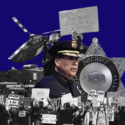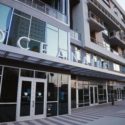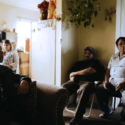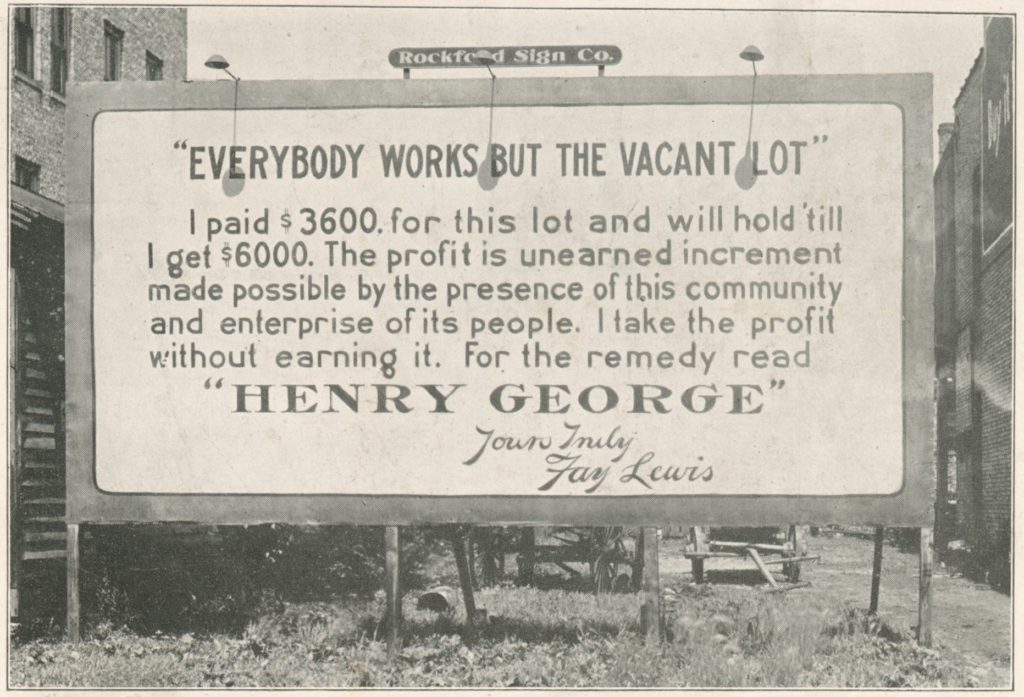‘Our Version of Stop-and-Frisk’: Black Cyclists Most Likely to be Stopped and Searched by LBPD
27 minute readKing Otha says he’s lost track of how many times police have pulled him over while on a bike in his 20-plus years living in Long Beach. The 41-year-old has gotten tickets for cycling without a bell, riding on the sidewalk, and even for not registering his bicycle—back when it was mandatory. He figures in total he’s gotten around six or seven bike-related citations and has been stopped many more times.
The bike stops have resulted in Otha being frisked, arrested, and even his bike being impounded. Yet, he says he’s never been convicted of a crime. A former city employee, he now works for Volunteers For America helping homeless veterans.
“It just really feels helpless, you know what I mean? Even though I’m a grown man … It is very nerve wracking,” he said.
He says Black cyclists, especially when riding through areas that are heavily policed, are constantly targeted and harassed by cops in Long Beach.
“(Police) figure if they get somebody on the bike, they’ll probably find some drugs or guns or some type of weapon on them,” Otha said. “You know, it’s more like a stereotype. They assume that if you own a bike, you probably can’t afford to fight your case, even if you’re not in the wrong.”
He adds that the frequent run-ins with police he and other Black people experience while riding bicycles is “most definitely” due to racial profiling. And the numbers seem to back him up.
Black cyclists in Long Beach were about 3.5 times more likely to be stopped for a suspected bike infraction than white cyclists in 2019, according to data from the Long Beach Police Department.
It’s a trend that is prevalent in many other cities across the nation.
Despite making up about 13% of Long Beach’s population, according to the U.S. Census, the police data shows that Black people accounted for 32% of all bike-related stops last year.
Meanwhile, white cyclists were stopped 9% less frequently than their share of the population.
THE DATA
This police stop data came about after the LBPD was required last year to begin collecting and reporting officer-perceived identity information, including race and ethnicity, on anyone they detained under California’s Racial and Identity Profiling Act (RIPA).
While the resolution of the RIPA data is not perfect because it relies on officer perception, it is the best available look into who law enforcement agencies around the state are stopping. When compiled, the data shows Black people make up 15% of all traffic stops statewide though they are only about 6% of the state population, according to a report from the California Department of Justice.
Somewhat complicating the interpretation of the data on bicycle violation stops is that there are no reliable demographic breakdowns of cyclists even at the state level, much less at the city level. That means our understanding of the racial makeup of Long Beach cyclists is limited.
“The problem is that most of the counts that are used to estimate the information generally severely undercount (people of color) bicyclists because they take place at traditional commute times or during the day on weekends, which frequently misses the riders who do so out of necessity,” said L.A. County Bicycle Coalition Senior Director for Policy and Partnerships Kevin Shin.
But even with that caveat, local cyclists we spoke to said the RIPA numbers reflect a reality that has gone unchecked for decades: that the LBPD uses minor bike infractions as a pretext to search or run a person’s name, and seem to be doing so in a way that disproportionately targets communities of color.
According to the data, majority white neighborhoods, most of which are bedroom communities on the Eastside, saw few stops for bike infractions. The vast majority of the 940 bike-related stops took place in communities that are majority people of color, such as the Washington and Poly High neighborhoods.
“Often what we see is that in ‘high-crime areas,’ which are obviously disinvested communities, is just a tremendous amount of bicycle stops for these small-level violations,” said Nikhil Ramnaney, an attorney at the Los Angeles County Public Defender’s Office assigned to Long Beach.
In its statement on the RIPA data, the LBPD said that the disparities seen in the numbers are indeed a reflection of where the department deploys resources.
“Our officers are frequently tasked with taking proactive enforcement action in areas that are experiencing high rates of violent crime in an effort to reduce specific crimes in our neighborhoods,” the statement read.
THE BIKE-TO-PRISON PIPELINE
Proactive policing, which targets certain people in certain neighborhoods, is nearly ubiquitous in modern law enforcement. The strategy of cracking down on low-level offenses by concentrating policing in areas deemed to have high crime levels has its roots in the largely discredited “broken windows theory” that emerged in the 1980s—and which has been carried out by many police departments based on a misinterpretation of the article that spawned the idea.
Critics of broken windows policing have blamed it for contributing to mass incarceration and the over-policing of Black and Brown communities. The logical conclusion of this type of policing strategy was the stop-and-frisk policy in New York City, that gave police near carte blanche to detain, question, and many times search a person. The policy was ultimately ruled unconstitutional in 2013 because it singled out young Black and Latino men.
LBPD officials said the department does not use stop-and-frisk tactics and that the department’s officers remain within constitutional bounds when stopping and searching cyclists. That means, in most cases, officers must have probable cause to detain a person.
And once detained, a cyclist has a high likelihood of being searched in Long Beach. While bike stops made up less than 4% of all traffic stops in 2019, they accounted for nearly a fifth of all searches.
But others say that because the law affords officers so much discretion to stop and search someone, what goes on is essentially the same as stop-and-frisk.
“If an officer says they saw a violation, there’s not going to be any challenge by judicial officers to their credibility on that issue. So it gives (police) almost unfettered discretion to pull over whoever they want,” said Ramnaney.
The Supreme Court has held that officers can conduct a pretextual stop to investigate someone further without violating their Fourth Amendment rights. This means an officer is allowed to stop someone for a minor infraction, such as biking without a headlight, even if the officer’s ulterior motive is to search the person.
And even if an officer is mistaken about the infraction, the Supreme Court has ruled that judges don’t necessarily have to throw out evidence—such as illegal drugs—found during the ill-founded stop.
Once detained, a cyclist has a high likelihood of being searched in Long Beach. While bike stops made up less than 4% of all traffic stops in 2019, they accounted for nearly a fifth of the searches.
About 40% of bike-related stops resulted in an officer searching the cyclist, according to the RIPA data, a jarring contrast to the 8.5% search rate of all traffic stops together.
About a third of the 378 searches stemming from bike stops turned up contraband, though a majority of it was drug related. Only 7% of the searches found any kind of weapon.
And there’s also wide racial disparities in who gets frisked. Black cyclists were about 4.5 times more likely to be searched than white cyclists, despite officers finding contraband on all races at about the same frequency, according to the RIPA data.
“In my experience, if you get stopped by the police while on a bicycle and you have a backpack and are Black or Brown, you are most likely going to be searched,” said director of Healthy Active Streets Danny Gamboa. “Your civil rights will be violated. I don’t have to look at data. I just know that from talking to the youth that I work with.”
Ramnaney says these bicycle stops work to perpetuate the criminalization of people of color.
“So many of my low-level felony cases are initiated by mostly bicycle stops, especially the nighttime violations for no front light or back light,” he said. “I have clients who are just stopped non-stop, like I mean five, six, seven, eight times a year. And every single one of those contacts is just another potential exacerbation of their criminal record.”
Police say more research is needed to understand why searches occur so frequently during bike stops, but that the nature of such stops might be a factor.
“Encounters with bicyclists put both parties in close proximity, and the conditions of the stop could warrant a search based on the totality of circumstances and legal considerations,” said said LBPD spokesperson Arantxa Chavarria.
But Ramnaney says that how close an officer and detainee are shouldn’t be enough justification for a search and only strengthens criticism that police training teaches officers to have a siege mentality, where every encounter is a potential threat and every person is an enemy. He says that he often sees officers justify searches of his clients simply because they were wearing baggy clothes or were cycling in a high-crime area or it was dark outside.
“I personally think that’s unconstitutional under Terry v Ohio. That’s not particular enough to be reasonable suspicion to frisk someone for weapons,” said Ramnaney. “I think (Long Beach police) just go from effectuating the vehicle code stop to frisking someone because, you know, how can you really challenge it?”
In a 2018 draft evaluation of the department’s operations by the International Association of Chiefs of Police (IACP), only recently made public, consultants questioned whether the LBPD’s policy manual provided officers with adequate guidance on lawfully conducting a search:
“The importance of officers constantly staying abreast of legal findings and cases cannot be overemphasized, as search and seizure is both vital to successful law enforcement and constantly changing. The IACP recommends that LBPD develop a complete policy that explains the legal requirements and procedures for the different types of searches that officers may encounter ranging from search warrants to exigent circumstances.”
But according to the department, all officers receive regular legal update training from the Los Angeles County District Attorney’s Office, U.S. Department of Justice, and various law enforcement organizations. LBPD’s Training Division also provides search and seizure training bulletins and in-service training on a regular basis, said Chavarria.
‘THAT’S HARASSMENT’
Chandler May ended up with a chipped tooth, stitches, and staples after he was tased by police in the middle of Long Beach Boulevard on May 11, 2017. Cops had initially stopped him for riding his bicycle without a headlight.
According to the police report, almost immediately after the stop occurred, Officer Edwin Oak pulled out his gun and asked May to interlock his fingers so that he could be frisked. In the report, Oak stated that he largely based this decision on May’s clothing:
“The suspect kept his hands near his front waistband and he was wearing a thick letterman style jacket and large black baggie pants. His front waistband area was difficult to see due to his hands and jacket. Based on my training and experience, I know that gang members and other subjects who carry firearms usually carry their firearm in their front waistband area.”
But May was not a known gang member, and nothing in the police report indicates that Oak had any reason to suspect so.
Oak also claimed to have seen a “bulge” in May’s front pant pocket. May said he didn’t have any weapons, but nonetheless Oak continued to order May to place his hands behind his back so he could be searched. May refused to comply with the officer’s orders for a few minutes, but eventually relented.
According to the police report, Oak first searched May’s front waistband and as he began to frisk his front right pant pocket, May tensed up, pushed Oak away, and said, “That’s harassment man.”
Oak told May he was under arrest, but May broke free from Oak’s grasp and ran into Long Beach Boulevard. That’s when another officer on the scene, Juan Ortiz-Ferrer, shot his Taser at May, who fell to the ground face first, according to the police report. He was taken to a hospital for treatment of a large cut on his chin. Photos from the scene show a pool of blood left behind on the asphalt.
In May’s pocket, investigators would later learn, were two empty marijuana containers, an empty mini liquor bottle, an EBT card, a cell phone, and two pens. Police did not find any weapons.
May was charged with resisting arrest and received probation. Officers later found out that May had an arrest warrant for trespassing in Los Angeles. A witness told officers that May was a known panhandler.
A strikingly similar pattern is also seen in other use-of-force cases that began as bicycle stops found among the many documents released by the LBPD under SB 1421, a statewide police transparency law.
In each of those cases, a Black man is stopped for a bike infraction. At some point he either argues with police or questions their motives. The exchange becomes tense. In some cases, police will justify a frisk because the cyclist has baggy clothing or a purported bulge under his clothes, or because of the area where the stop took place, further aggravating the cyclist. The cyclist tries to flee or resist in some way, which is when they are either tased or hit with a baton before being arrested. In each of the cases, the cyclist ends up in the hospital and is ultimately charged with at least one count of resisting arrest.
“What you’re seeing in some of those reports is that escalation and assertion of your rights is met with fierce resistance and poor deescalation training by these cops,” said Ramnaney. “It’s very apparent that it’s discriminatory, pretextual enforcement. And so, you get that attitude from someone who’s like, ‘Are you really busting me for riding my bicycle on the sidewalk?’”
Otha says the frustration and psychological trauma caused by being constantly profiled and harassed by police can naturally result in outbursts and outrage directed at nitpicking officers.
“I know when I was getting done wrong, I’m just going off (on the police), saying, ‘You guys are wrong. This is not right,’” he said. “The police look for any reason to stop you. You can walk the wrong way, you can sneeze, you can walk a dog, ride a skateboard. It don’t matter what I do. They want to know where I’m going, what I’m doing, and why.”
A NEAR DEATH SENTENCE
Solomon Brooks faced down a potential life sentence after being stopped by LBPD officers in 2016 for not having a headlight on his bike. The confrontation escalated and resulted in Brooks being tased, pepper sprayed, and hit with a baton by police.
Officers alleged he had thrown his bike at them and Brooks was charged with assault with a deadly weapon. A conviction would have given Brooks his third felony, mandating a lifetime behind bars under California’s Three Strikes sentencing law. However, the jury cleared him of the assault charges, dinging him only for a lesser charge of resisting arrest, for which Brooks received a year in prison.
Tomisin Oluwole
Fragmented Reflection I, 2021
Acrylic on canvas panel
24 x 30 inches
Click here to check out our interview with Tomisin Oluwole, a literary and visual artist based in Long Beach.

Instead of gunking up our site with ads, we use this space to display and promote the work of local artists.
“If the defendant just stops his bike, he gets a verbal warning … At worst—maybe officers are in a bad mood that day—he gets a citation,” then-Deputy District Attorney Drew Harbur told the jury.
The officers, Brady Vriens and Leticia Newton—who were still employed by the department as of last year, according to the most recent data from Transparent California—were cleared of any wrongdoing by Internal Affairs. A complaint about the arrest was filed with the Long Beach Citizen Police Complaint—recently criticized by its own members as being ineffectual and a “farce”—but it was determined to be unfounded. However, Brooks and his attorney maintained the officers’ use of force was inappropriate.
In 2018, a traffic stop for various bicycle infractions, including not having a headlight and riding on the sidewalk, ended with a cyclist being shot by police. Luis Perez allegedly failed to comply with officers’ orders during the stop, and fled on foot.
The Los Angeles County District Attorney’s report about the police shooting said that when Officer Adrian Guzman caught up with Perez and tried to arrest him, there was a struggle. Guzman said he punched Perez three times in the head and then Perez punched back, hitting the officer in the face multiple times, according to the DA. That’s when Guzman said Perez tried to take his gun, prompting the officer to unholster his firearm and order Perez to the ground. Perez did not comply and Guzman shot him in the lower torso. According to the report, Perez denied punching the officer or reaching for his weapon. He was hospitalized, but his injuries were not life threatening.
Two years later, the DA cleared Guzman of any wrongdoing in the case. According to the most recent data from Transparent California, he is still employed by the LBPD.
Perez took a plea deal and was convicted of resisting arrest.
CONFUSING BIKE LAWS
The sheer complexity of bicycle laws can make bike riders easy targets for police, according to some advocates.
Cyclists are governed by the California Vehicle Code, which for the most part gives bike riders the same rights and responsibilities as motor vehicle drivers.
According to the RIPA data, the most common vehicle code violation cyclists were stopped for was not having a headlight at night and riding on the wrong side of the street, which combined accounted for more than three quarters of all bike-related stops.
On top of that, local ordinances also set additional rules that cyclists must abide by.
For example, while there is no state law prohibiting bike riding on sidewalks, the Long Beach municipal code bans bicycles on the sidewalk in business districts. This sounds simple enough until you try to figure out what that means exactly. The municipal code does not define a business district, but Deputy City Attorney Amy Webber said enforcement is based on “whether there are businesses operating on the street.”
A more detailed, though murky, definition of a business district can be found in a subsection of the California Vehicle Code, which says a stretch of road is a business district if at least half of the buildings fronting it are “business structures” for a distance of several hundred feet.
Churches, apartments, hotels, multiple dwelling houses, clubs, and public buildings are all considered business structures.
“The definition of these districts is so ambiguous that even me, being an attorney, so much of my time is spent determining if a place is actually qualifying as a business district or a district where sidewalk riding is appropriate or not,” said Ramnaney, who is himself a local cyclist.
The city does not provide any type of map to help cyclists navigate the confusing sidewalk riding rule.
Webber said that enforcement of the rule is “complaint-based.” But Ramnaney says he’s never seen a police stop in Long Beach for cycling on a sidewalk that was based on a complaint.
And depending on your neighborhood, the decision of where to ride can involve serious safety considerations, as cyclists are one of the most vulnerable groups on the road.
“We still see folks riding their bicycles on the sidewalk because they don’t feel safe (on the street). So I tell them, ‘Do you want to feel safe? Or do you want to do something that might have you get pulled over and possibly cited?’ You know, that’s a personal decision,” says Gamboa, who holds bicycle safety workshops in the city. “I teach the actual law and try to explain that.”
According to the city, 73% of high-injury corridors and 83% of high-injury intersections are in disadvantaged communities. While the city often touts how bike-friendly it is, Gamboa points out that there are currently no dedicated bike lanes in the Westside or the Anaheim corridor, which are predominantly communities of color.
Between 2013 and 2017, 67 cyclists were either killed or seriously injured in collisions in Long Beach, according to the city.
And while one of the top reasons LBPD tickets cyclists is for riding on the wrong side of the road, the city’s Safe Streets Long Beach Action Plan says bike riders often travel “on the wrong side due to limited safe crossing opportunities.”
In instances where an officer stopped a person suspected of violating a local traffic law—which happened 355 times in 2019—the RIPA data does not specify the ordinance. However, citation data from the LBPD shows that officers have ticketed 942 people since 2014 for riding a bicycle on a sidewalk in a business district. Over three quarters of those tickets were issued to people of color.
“It don’t matter where I ride. I’ll ride on the street and I get pulled over. (The police) say don’t ride on the street, ride on the sidewalk. Ok, I ride on the sidewalk and I get pulled over,” Otha said.
Gamboa says another Draconian bike law on the city’s books prohibits more than two cyclists from riding abreast on streets. He notes that this effectively bans group rides or political actions like Critical Mass.
One obscure state-level law says that a bike’s handlebars can’t be above the rider’s shoulders—prohibiting the use of many lowrider bikes, which have a rich history in the region. Twelve people were stopped for that last year.
Ultimately, the opaque nature of bike laws sets up a situation where virtually every cyclist can be observed committing a minor infraction if they’re followed for long enough by police. Yet the numbers show this leeway provided by the law to officers is used disproportionately in lower-income neighborhoods and on people of color, especially Black cyclists.
Tiffany Davy, a local environmental justice advocate, called bike stops “our version of stop-and-frisk.”
She recalled one night while cycling, a patrol officer followed her for a block and a half to her home only to inquire about her bike light, which had dimmed along the way because the battery ran out.
Although she did not receive a citation, she says it gave the officer an opportunity to question her as she was walking to her door. She says she was fortunate enough to be able to go inside before anything more could happen. Even so, the interaction left a lasting impression.
“You’re trying something that’s for your health. You’re doing the right thing by cutting vehicle emissions,” she said. “And the bike light thing seems like complete bullshit. And it felt really predatory.”
CITATIONS
Since 2014, the LBPD has issued 3,157 citations for bike-related offenses. Of those, Black cyclists received 35% while white cyclists received 19%, according to LBPD data.
Like with bike-related stops, this again shows disproportionate enforcement when compared to the racial breakdown of the city’s population.
Though U.S. Census figures about transportation can be fuzzy, they indicate that the largest share of people who bike in major cities across the nation are in lower-income brackets. This is echoed in the city’s recent Safe Streets plan.
In Long Beach, 21% of Black households do not have access to a motor vehicle, compared to 10% of Latino households and 7% of white households, according to a report by PolicyLink. Research also shows that biking is an important form of transportation for low-income Latino immigrants.
And the fines attached to bike tickets can often be in the hundreds of dollars, with penalties added if a person puts off paying it. Wages can be garnished or jail time can be ordered for those who can’t or don’t pay their citation, miring the bike rider deeper into the criminal justice system and the cycle of poverty.
“You could walk out of court owing $1,500 over just riding a bike without a light. So it’s a real cash crop,” said Otha.
As part of the Black Lives Matter movement, there have been calls to reduce police involvement in traffic enforcement. And at least one California city is listening. Shin says at the very least law enforcement should change their punitive approach to bicycle enforcement to an educational one.
“By citing someone, all it really does is it escalates (the situation) and it compounds that person’s problems,” he said. “We try as much as possible to encourage law enforcement—unless there’s something really egregious about the way someone’s riding—to provide an educational moment, rather than making it a citation or some other confrontation.”
He added that it would be even better if these educational moments could be delivered proactively before a rider gets themselves into trouble and by someone other than an armed officer.
The LACBC tries to work with law enforcement agencies to help them better understand what an educational approach to bicycle safety looks like. However, Shin says the LBPD, like many police departments, has not been receptive to the idea of having an outside group educate them on the topic.
Notably, the number of bicycle citations has gone down substantially since 2014, when 860 citations were issued by the LBPD in contrast to 304 in 2019, according to police data. The disparities, however, remain. Last year, Black cyclists received a third of all bike-related citations in the city.
Part of the city’s Safe Streets plan is to implement a diversion program for people cited for a violation while riding a bicycle: “The diversion program should offer cited bicyclists an option to take a bicycle safety class in lieu of paying fine.”
A PUBLIC HEALTH CRISIS
Residents, community leaders, and city officials are all grappling with how to end the structural racism that exists in Long Beach, with its police force being the most visible and visceral representatives of that oppression for many.
The uprising and subsequent months of action that followed the death of George Floyd in Minneapolis have woken up the monoliths of power in the city, forcing them to react.
The LBPD recently announced the formation of an Office of Constitutional Policing, though it remains unclear what its authority will be or whether it will be headed by a constitutional attorney.
Last month, Mayor Robert Garcia and City Manager Tom Modica unveiled the proposed budget for the upcoming fiscal year, which takes a small bite out of the police department. Though how much of that is due to the dire economic forecast brought on by the coronavirus pandemic and how much is due to civil unrest is unknown.
The cuts amount to 5.2% reduction to the police department’s budget—though the figure dwindles to 1.6% without counting cost growth increases.
In a recent interview, Garcia called the budget cuts and ongoing work around equity a “launching pad for the future.”
Dawn Modkins, co-founder of Black Lives Matter Long Beach, at a rally outside of City Hall on Tuesday said the process of pushing the city toward a more equitable horizon has so far has been “extremely frustrating.”
“At this same time we’re in a health pandemic, we’re also in a racial-related pandemic,” said Modkins. “Racism has been declared a public health crisis. That’s the moment that we’re in. And how do we address that in a way that invests in a real reconciliation, or a restoration, of the harm from that historical racism? That has to get reflected in the budget.”
During the council’s first budget hearing last week, one councilmember, Jeannine Pearce, said the budget cuts to the police don’t go far enough. The council is set to tackle the police budget in earnest on Aug. 18.
The city is also in the midst of its Framework for Reconciliation, meant to, in part, gather input about racial inequities from the community. An analysis of the comments made during its 11 listening sessions four town halls held so far found that:
“Many community members did not see police officers as the bearers of safety in Black and Latinx neighborhoods. Many community members described interactions with police as traumatic experiences that often happen as young or mid adolescents. There were community members who expressed that their police interactions trigger fear and trauma when they interact with police officers.”
This echoes Otha’s experience, who says his countless run-ins with police have caused him long-term mental anguish.
“I had to go see a psychiatrist and all this shit because I couldn’t focus on school, you know, with the harassment, daily harassment,” said Otha.
Like Davy, Otha also stopped riding his bike largely due to the constant run-ins with police, but says he misses it.
“No gas, you get the breeze, you can get anywhere you want quick,” he said. “It was one of my joys of life.”

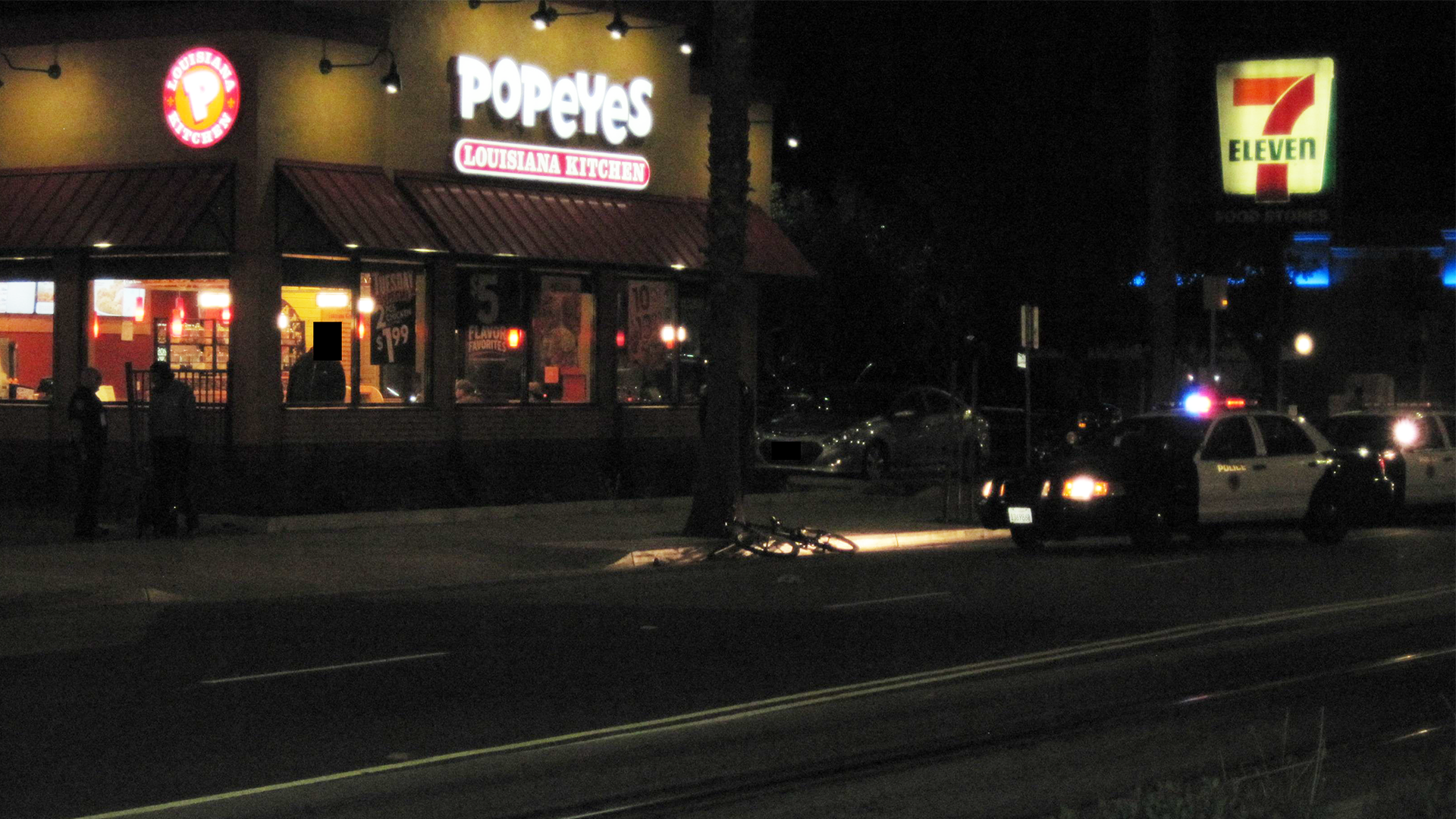
 kevin@forthe.org
kevin@forthe.org @reporterkflores
@reporterkflores